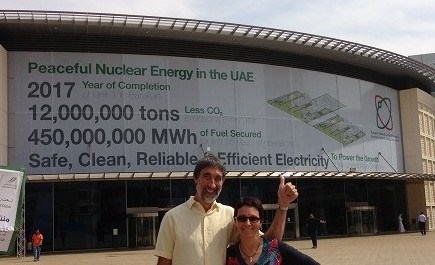 I’m currently in Dubai at the 2012 World Energy Forum, as part of a delegation from the Science Council for Global Initiatives. Tomorrow (24 Oct) we will run symposium on “New Nuclear”, which will be chaired by Tom Blees and feature talks from Dr Eric Loewen (GE), Dr Alexander Bychkov (IAEA), Dr Evgeny Velikhov (Kurchatov Institute) and me (Dr Barry Brook, University of Adelaide). I will also chair a session later in the afternoon on “Vision for a Sustainable Future”, just before the closing address.
I’m currently in Dubai at the 2012 World Energy Forum, as part of a delegation from the Science Council for Global Initiatives. Tomorrow (24 Oct) we will run symposium on “New Nuclear”, which will be chaired by Tom Blees and feature talks from Dr Eric Loewen (GE), Dr Alexander Bychkov (IAEA), Dr Evgeny Velikhov (Kurchatov Institute) and me (Dr Barry Brook, University of Adelaide). I will also chair a session later in the afternoon on “Vision for a Sustainable Future”, just before the closing address.

Tom and Nicole Blees of SCGI stand in front of the World Trade Centre in Dubai, during the World Energy Forum, Oct 2012. The sign behind them makes for some interesting reading…
In preparation for this meeting and as a result of a focussed conference at University of California Berkeley in early October, a white paper on the Integral Fast Reactor was prepared by Tom and me, on behalf of SCGI, and has garnered signatories from 8 key countries, including prominent people not attending the Berkeley meeting, such as climatologist Jim Hansen. The white paper is given below.
——————-
The Case for Near-term Commercial Demonstration of the Integral Fast Reactor
Demonstrating a credible and acceptable way to safely recycle used nuclear fuel will clear a socially acceptable pathway for nuclear fission to be a major low-carbon energy source for this century. We advocate a hastened timetable for commercial demonstration of Generation IV nuclear technology, via construction of a prototype reactor (the PRISM design, based on the Integral Fast Reactor project) and a 100t/year pyroprocessing facility to convert and recycle fuel.
1. Synopsis
We propose an accelerated timeframe for realizing the sustainable nuclear energy goals of the Generation IV reactor systems. A whole–system evaluation by an international group of nuclear and energy experts, assembled by The Science Council for Global Initiatives, reached a consensus on the synergistic design choices: (a) a well-proven pool-type sodium-cooled fast reactor; (b) metal fuel, and (c) recycling using pyroprocessing, enabling the transmutation of actinides. Alternative technology options for the coolant, fuel type and recycling system, while sometimes possessing individually attractive features, are hard-pressed to be combined into a sufficiently competitive overall system. A reactor design that embodies these key features, the General Electric-Hitachi 311 MWe PRISM [1] (based on the Integral Fast Reactor [IFR] concept developed by Argonne National Laboratory [2]), is ready for a commercial-prototype demonstration. We advocate a two-pronged approach for completion by 2020 or earlier: (i) a detailed design and demonstration of a 100 t/year pyroprocessing facility for conversion of spent oxide fuel from light-water reactors [3] into metal fuel for fast reactors; and (ii) construction of a PRISM fast reactor as a commercial-scale demonstration plant. Ideally, this could be achieved via an international collaboration. Once demonstrated, this prototype would provide an international test facility for any concept improvements. It is expected to achieve significant advances in reactor safety, reliability, fuel resource sustainability, management of long-term waste, improved proliferation resistance, and economics.
2. Context
When contemplating the daunting energy challenges facing humanity in the twenty-first century in a world beyond fossil fuels, there are generally two schools of thought [4].
Filed under: Emissions, Future, IFR FaD, Nuclear | 4 Comments »






.png)






